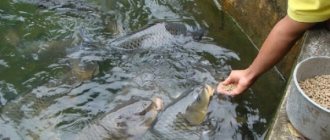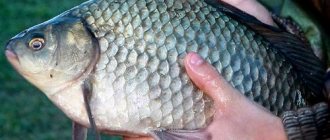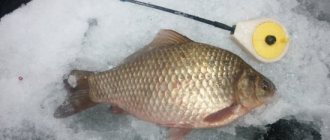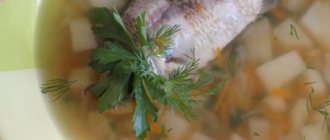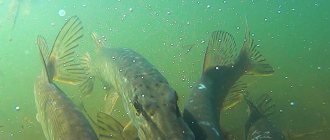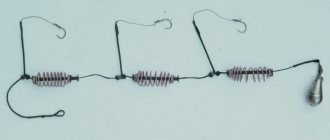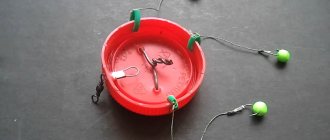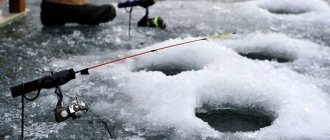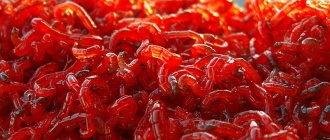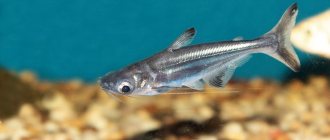Article rating 4.5/ 5 rating (21 votes)
Often, while fishing, there is a desire to keep a few fish alive in order to please your family, or to set up an impromptu aquarium. An excellent candidate for this role is the common crucian carp. It is extremely unpretentious, has an acceptable size, lives in many bodies of water and is easy to catch with a fishing rod. Before bringing a crucian carp home, it is advisable to prepare its new home in advance. But if this idea arose spontaneously, then it is allowed to do everything gradually.
Description of fish
Oddly enough, crucian carp are the direct ancestors of the goldfish, the heroine of most fairy tales and legends. But river fish of the carp family are much larger than their direct descendants. The body shape of domestic crucian carp in the aquarium comes in two types. The fish has either an oblong or slightly rounded body, slightly flattened on the sides. Smooth large scales are reliable armor for crucian carp.
The color of the fish depends on the variety and can vary from silver to golden color. A high fin adorns the thick back of the fish. The weight of crucian carp can reach more than five kilograms, and the length can be more than 50-60 centimeters.
The fish's head is small with small eyes and mouth. The fish's teeth are arranged in one row and are small and sharp. Spiny barbs in the dorsal and anal fin are a distinctive feature that allows you to recognize crucian carp among other fish.
How long does crucian carp live in an aquarium? More than twelve years. Depending on the type of fish, the lifespan can range from 8 to 14 years.
What do crucian carp look like?
Crucian carp, depending on the species, can look different, for example, silver crucian carp has a unique color of scales that shimmer in numerous shades: asphalt gray, slightly golden, and there are also orange-pinkish nuances in the color of its scales.
Silver crucian carp differs from ordinary carp in that it has a pointed muzzle when viewed from a side angle. The tail fin of the crucian carp is clearly defined, the rays of the fins are smooth, soft, this variety of crucian carp reproduces by gynogenesis.
Let us, dear readers, turn to the appearance of the golden or common crucian carp: this river inhabitant has a rounded head shape, if you look at it from the side, the scales covering the body of the crucian carp are cast in gold, the ventral, caudal and dorsal fins have a rich dark brown, slightly brown shade.
Only a few species of fish are as well known among people as crucian carp
This is one of the most common fish in our inland waters. However, not everyone knows that it is among crucian carp that forms with amazing biological properties have been discovered, the study of which can suggest the correct answer to important theoretical questions. Numerous breeds of aquarium fish have been bred from wild crucian carp, striking in their quirkiness and diversity of body shape and color. Of course, not only aquarium lovers or scientists engaged in theoretical research are interested in crucian carp.
Vegetation in the diet of fish
Ideally, the carp diet should contain 20-30% vegetation. The fish's favorite green diet is duckweed, but they do not refuse sedge, cattail, reed, etc. You can give very young and soft chopped grass from the lawn; fish eat clover especially well.
The greens are prepared right before feeding the fish, a maximum of two hours, and crushed in a chopper or a more modern device.
The essence of the cutting machine: you turn an iron wheel, four knives rotate through the gears, and grass is fed through a special trough, which is cut into approximately centimeter pieces.
Aleksej2000 was mowing the grass along the shore of the pond and noticed how the carp “began to savor” a hard and prickly reed leaf, which the wind had carried to the middle of the pond. At the same time, there was a sea of grass around, and in the pond there were two types of duckweed in abundance. But these are the creatures they are, fish.
FORUMHOUSE participants even give the fish grated cucumbers and herbs. Cucumbers are especially respected by silver carp and grass carp.
One of the few baits that can actually catch carp or silver carp is a piece of cucumber.
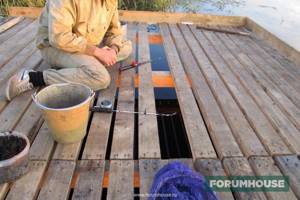
I had a ton of English lettuce, I was already thinking about throwing it away, and then a brilliant idea, as it turned out, came to me: offer it to the fish. I cut it and put it in a frame. They eat it clean!
Proper feeding of fish is extremely important - the more fat the fish gains, the easier it will survive the winter.
Silver fish
The body color of this extraordinary fish is light gray with a metallic tint. The back is a little darker. The shape of the silver crucian carp is more oblong than that of its golden relative. Since young fish are in no way inferior in size to adult fish, their distinctive feature is their scales. In adult waterfowl, the cover is thicker and rougher. To keep crucian carp in an aquarium, it is recommended to purchase small fish.
The fish is the most undemanding to care for. Even for spawning, it requires a water temperature of no higher than 14 degrees. These are very cold-loving creatures. For wintering, the temperature of the water in the container should not exceed 8 degrees. In such an environment, pets hibernate and do not eat.
What kind of reservoir should a body of water be in order to grow fish in it?
If you already have a reservoir at your dacha - it could be a stream with a dam built on it, or something else, then you are very lucky. For those who don’t have this, you can read the article further, because making your own pond is quite possible.
The suitable dimensions of your pond can be somewhere around 4x6 m, with a depth of 1 to 1.5 m. This is the optimal depth, since the water in such a reservoir will heat up well to a temperature of 25 degrees, which is quite enough for the good development and habitat of small crucian carp, the number of which can reach a couple of dozen with a weight of 250 g.
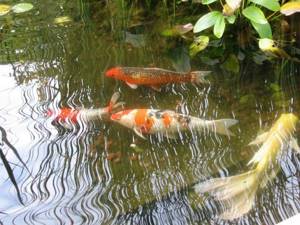
The size of farmed crucian carp is directly proportional to the size of the reservoir itself
Before introducing animals into the pond, it is necessary to adjust the temperature so that it is the same as in the previous reservoir. Otherwise, even a difference of 3 degrees can destroy the fauna.
Crucian carp for a home pond (video)
If you are planning to breed crucian carp, it is important to consider one point - there are two types of it - golden and silver. The second type develops more productively, and its mass is rapidly gaining. Therefore, we recommend farming silver crucian carp.
We also recommend reading
Male silver crucian carp are found quite rarely. Females are the main offspring of crucian carp. However, this does not slow down the spread of the species at all, since neighboring males are quite suitable for this task. To breed crucian carp, it is enough to have females aged 4 years, who have a compressed side and a tall body - they have fairly healthy offspring that develop quickly.
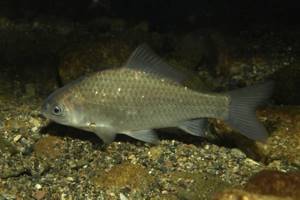
Silver crucian carp is recommended for a home pond
Golden crucian carp
Another name is ordinary. The natural habitat of golden crucian carp is rivers and reservoirs with weak currents. In an aquarium, the fish can grow up to 20 centimeters, although in natural conditions there are individuals 45-47 centimeters long.
The color of the scales of golden crucian carp has a reddish-brown tint. The body is more rounded than that of its relative, the silver fish. The pet is quite unpretentious in care. The golden crucian carp overwinters at the bottom of the container, burrowing into the silt. Polluted water is not a problem for him, since he can easily survive in an environment poor in oxygen.
You can breed golden crucian carp starting from the age of three or four years.
Home pond and crucian carp: features of breeding and feeding
Crucian carp is one of the most favorite fish among many anglers. In nature, it lives in almost all reservoirs of our country. But it can also be easily grown in a pond at your own summer cottage. This is a very interesting and quite profitable activity. Firstly, you can enjoy fishing in comfortable conditions, and secondly, you can prepare a very tasty dish from your catch.
Breeding crucian carp in a country pond raises a lot of questions for most people. Therefore, let's figure out how to grow these fish in a garden pond, and consider some useful recommendations.
Lucky are those who already have a pond on their summer cottage (a fire pond, a dam on a stream, part of a clean and fenced drainage canal). But if there are no such reservoirs, then you can make your own garden pond.
The optimal size of a country pond is approximately 4x6 m, and its depth varies from 0.8 to 1.5 m. The water in a garden pond will quickly warm up to 25°, which is considered the most suitable temperature for the normal functioning of fish. This small pond is perfect for housing two dozen crucian carp weighing 200-300 g.
Before launching crucian carp, you need to equalize the water temperature between the reservoir from which you are transferring the fish and your pond. Otherwise, a temperature difference of even 2-3° can cause temperature shock and kill the fish.
When growing crucian carp, you need to take into account one interesting nuance - of its two types (gold and silver), the latter is more productive and gains weight much faster. Therefore, it is recommended to breed silver crucian carp.
In nature, male goldfish are very rare. And most of the crucian carp offspring are females. But this fact does not at all slow down the reproduction of this species, because males of similar breeds are successfully used for this - golden crucian carp, carp, carp. For breeding, it is advisable to take females 4-5 years old, with a tall body compressed from the sides - the offspring of such specimens grow much faster, gaining weight well.
The natural diet of crucian carp is quite varied - algae, duckweed, bloodworms, as well as other living creatures that live on the bottom. Therefore, if the pond is properly equipped, there should be plenty of food here. If the reservoir is newly equipped, it does not yet have such a varied menu. Then some difficulties arise with natural nutrition, and the fish have to be fed.
There are no difficulties when feeding crucian carp. For feeding, you can take worms or insect larvae. After all, digging up worms or collecting larvae in a garden plot will not be difficult at all. In addition, you can diversify the fish menu with steamed beans and grains.
To make the feeding process as simple as possible, you can use ready-made food produced for feeding pets. Feed for chickens or pigs is excellent for this. Before adding them to the pond, they need to be soaked with water and made into a thick dough. In addition, special food for crucian carp is also sold. This food is enriched with air so that its grains remain on the surface of the reservoir without clogging the bottom.
Feed flakes to the fish little by little, otherwise they may fall to the bottom and sour there.
The following dishes are best eaten by crucian carp:
- seaweed;
- duckweed;
- steamed beans, grains, cereals;
- worms;
- insect larvae;
- bloodworm.
It is not advisable to feed them bread, because it quickly turns the water sour and spoils.
The main thing is not to overdo it when adding complementary foods. The amount of feed introduced should be a maximum of 5% of the weight of the crucian carp. Calculating this rate is quite simple. If there are 30 fish in a pond, each weighing approximately 200 g, then the total weight of the fish is approximately 6 kg. Accordingly, a single feed rate should not exceed 300 g.
It is best to feed crucian carp 1-2 times a day, at the same time, in the same place in the reservoir. Fish farms install a bell at the crucian carp feeding site, which rings before each feeding. It is advisable to do this in order to form a conditioned reflex in the crucian carp. Thanks to this, the crucian carp finds food faster and assimilates it better. In addition, all the food is eaten without disappearing at the bottom.
The appetite of fish is affected by the weather and the temperature of the water in the reservoir. In early spring, after waking up, crucian carp are fed more nutritiously than in summer. During the hot season, crucian carp does not eat so much, being content with what it independently finds in the garden pond. The colder the water, the more lethargic the fish will be. Therefore, in the fall, after the water temperature drops below 10 degrees, they stop feeding the fish altogether.
When raising crucian carp in an indoor pond that is heated in winter, there is no need to stop feeding.
In order for feeding fish to give the desired result, you must adhere to the following rules:
- The dry mixture cannot just be thrown around the pond. Before feeding, you need to add a little water to the bulk food and knead a thick dough, and then add it to the pond.
- It is always necessary to feed the fish at the same time, in the same place, in order to develop a conditioned reflex.
- If feeding occurs in the evening, the area must be additionally illuminated. The crucian carp will reflexively react to the lighting, time, and place of feeding, which will simplify its catching in the future.
- It is advisable to provide the feeding area with a wide metal tray. It is best to make it from galvanized iron. It must be equipped with a lifting device. Thanks to this, it can be easily immersed in and out of the pond. This tray is needed primarily so that you can monitor how the food is eaten. With its help, you can regulate the amount of food supplied so that excess food does not turn sour or begin to rot. As a result, the water will always be clean.
When creating a home pond, it is necessary to take into account that in the hot summer the water level can drop significantly. Naturally, the amount of fish also needs to be reduced.
The main sign of crowded conditions or lack of oxygen is that the crucian carp rises up and begins to gasp for air.
It is possible to breed crucian carp in a dacha pond only in spring and summer, and in the fall they will have to be caught. During the cold season, the fish burrows into the mud and goes into hibernation. It is not advisable to leave crucian carp until spring, because in a small pond under thick ice there will not be enough oxygen for it.
You can stock the pond again in early spring. Because the earlier you launch the fish, the larger it will be by the end of the season. And to make the ice on the pond melt faster, you can crush it with coal dust, peat chips or ordinary soil.
From the video you will learn how to create your own fish pond:
Other types
In addition to traditional varieties, there is also the heroine of folk tales - the goldfish. She is a direct descendant of the silver crucian carp. All representatives of this species (and there are about three hundred of them) are intended for living at home. All goldfish differ in size, which range from 2 to 45 centimeters. The next distinguishing feature between the varieties of domesticated crucian carp is the color of the scales, which can be almost all colors of the rainbow. The length of the body, fins and tail will also help distinguish one subspecies of pet from another. Notable are the eyes of the fish, which vary from small to large and bulging.
In addition to goldfish, the so-called Japanese crucian carp lives in the waters of Japan and Taiwan. The size of the fish ranges from 35 to 40 centimeters. It is practically impossible to domesticate and exists only in the wild.
What do crucian carp eat?
Crucian carp eats literally all small-sized waste that comes under the sight of its attentive gaze, so this fish is classified as omnivorous. Newly born, grain-sized fry use the filling of the yolk sac, which remains after embryonic development, to maintain their life cycle.
Living in warm, gentle waters, the fry actively develop and, having matured a little, begin to overeat the daphnia, crustaceans, and remains of blue-green algae that live in the lakes.
Once the fry reaches one month of age, their diet becomes more varied; now crucian carp can feed on bloodworms and the smallest larvae of various insects floating in the water column.
In adulthood, crucian carp love to feast on annelids , pay attention to small crustaceans, and happily consume the roots and stems of coastal plants, duckweed, algae remains, and also eat insect larvae.
Nevertheless, this has not quenched the crucian carp’s love for man-made baits; it also still loves to eat boiled cereals (buckwheat, pearl barley, millet), and does not remain indifferent to dough and bread crumbs, fully flavored with butter.
Type of fish and feed used
- silver crucian carp (from the Latin Carassius gibelio). This species of crucian carp previously lived only in rivers belonging to the Pacific Ocean basin. But today, due to the fact that there was once a time when artificial resettlement took place in the middle of the 20th century, the habitat of this species of crucian carp has increased by an order of magnitude, silver crucian carp began to live in the reservoirs of Poland, Romania, China, Siberia and Germany . Moreover, in many of these countries, this type of fish began to show off on the championship podium instead of its original owner - the golden crucian carp. The dimensions of the silver crucian carp are an order of magnitude more modest than the dimensions of the gold crucian carp, but this does not prevent the first variety from having an amazing ability to adapt to environmental conditions; the scales of this fish are cast in silver, and greenish nuances are visible in its color. The fins of goldfish are transparent and have a slightly pink tint. Being residents of lakes, peat quarries or ponds, crucian carp can migrate to neighboring reservoirs, which is why they are found in large quantities in reservoirs near fish farms;
- common or golden carp . The natural habitat conditions of crucian carp favor an increase in the lifespan of common crucian carp up to 12 years; these individuals become sexually mature 3-4 years after birth. The peritoneum of the common crucian carp is devoid of pigmentation, the back of the individual has a brownish color, the scales of the crucian carp flare up in golden-copper, bronze shades in the sun. Golden crucian carp dotted the reservoirs of Europe, representatives of this species are found in the cool waters of Sweden, Great Britain, Norway, the distribution area of golden crucian carp also includes the warm reservoirs of Croatia, Italy, and Macedonia;
- Japanese crucian carp . Inhabits the reservoirs of Japan and Taiwan, wild varieties of crucian carp have found a cozy refuge in lakes Biwa and Japan, the length of the Japanese crucian carp is approaching 35-40 cm.
Necessary equipment
Perhaps the most basic item in a home fish container is the filtration system. Although crucian carp are not afraid of muddy water, it is still advisable to install an external filter on the aquarium, which, in tandem with the internal one, will ideally perform its main function. An external installation makes it possible to keep a large number of fish in tanks. The internal unit removes the turbidity raised by the fish from the bottom of their home. The best option for caring for crucian carp in an aquarium is to install a phytofilter.
Another important device in a fish’s home is the compressor. The functions of this device are as follows:
- The compressor is designed to provide aeration for the aquarium. Air bubbles formed as a result of the operation of the device saturate the vessel with additional oxygen.
- Thanks to the compressor, the water in the container is mixed. This significantly improves the quality of the aquarium contents. If the container is equipped with a thermoregulation system - a thermostat, then the heated layers of water due to the operation of the compressor are mixed with cooled ones. This way the optimal temperature is maintained.
- This installation gives the aquarium an aesthetic appearance.
- The compressor prevents the formation of a film on the surface of the water. As a result, the appearance of harmful bacteria and dust is prevented.
- Crucian carp are fish accustomed to living in natural bodies of water with moderate currents. Standing water in an aquarium causes some discomfort for pets. A compressor eliminates this problem. As a result of its functioning, water moves, simulating the flow of a river. Fish will swim in such a vessel with great pleasure.
Tips for feeding crucian carp
To achieve a certain effect in feeding fish, it is important to fulfill certain requirements:
- It is prohibited to add dry food to the pond. It is necessary to moisten it before feeding, make dough out of it, and only after that feed it to the fish.
- Feeding must take place exactly on schedule to develop a conditioned reflex.
- In the evening, the feeding area must be provided with lighting. The fish will develop a reflex to the light and feeding point, which will make catching the fish easy.
- Build a fish feeder from a wide metal tray. Galvanized iron is the best option for the material used. The pallet must be equipped with a lift. This will make it easier for you to lower and lift it out of the water. This way you can control the amount of food you eat, which will prevent premature contamination of the pond.
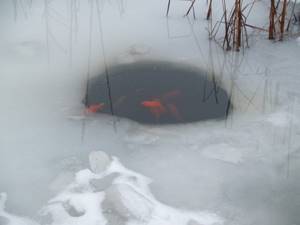
In any body of water, both natural and domestic, it is important to take into account one point - in hot and dry summers, the amount of water in it may decrease. Accordingly, the number of crucian carp also needs to be reduced.
It is easy to determine the lack of oxygen in the water - if the fish floats to the top and opens its mouth, this is an alarming sign.
Reproduction of fish in a dacha pond is possible only in spring and summer, and in autumn they must be removed from the reservoir. This is explained by the fact that there is a small volume of water in a home pond, and when the ice freezes, the fish simply will not have enough oxygen and will die.
It is allowed to re-introduce fish in the spring. And it is recommended to do this as early as possible, so that it can grow as much as possible before autumn. In order for the melt to melt faster, you can pour ordinary soil on top.
Decorations
There are many options for decorating a pet's home. The main thing in using decorations is that the habitat replicates as closely as possible the natural living conditions of crucian carp.
One of the ways to decorate an aquarium is to cover the bottom with coarse river sand mixed with large river stones without sharp corners. Several driftwood arranged in the form of rubble will create the effect of a natural pond. All elements of decorations must be carefully processed before placing in the aquarium. In this way, it is possible to avoid the development of harmful organisms in the container.
As an external background, in order to create the effect of a real pond, you can use a film of dark colors (black, blue, etc.).
landscaping
Crucian carp are cold-loving fish. Therefore, not all plants are suitable for fish’s home. On the other hand, due to the omnivorous nature of crucian carp, not all landscaping can remain intact. Therefore, plants that can withstand a water temperature of 17-20 degrees Celsius are ideal for an aquarium with crucian carp. Such options are hornwort, elodea, pinnate, vallisneria, and key moss. The surface of the liquid can be decorated with duckweed, water lilies, and egg capsules. To reduce the fish’s craving for eating green decorations, it is recommended to include plant foods in the diet. Both industrial seasonings and scalded green salad leaves or nettles are suitable.
Feeding in summer
In summer, feeding pond fish should be limited when the water temperature rises to 26-30 degrees Celsius. This is due to the fact that as the water temperature increases, the solubility of oxygen decreases. It becomes more difficult for the fish to breathe. They literally begin to “swallow air” at the surface of the water. In such cases, the food will only harm the fish.
You should feed the fish in the morning!
The weight of the fish depends on its age. The older the fish, the heavier it is. A young, growing body needs more nutrients and proteins. Therefore, high-protein balanced feeds are used for juvenile fish and fed 2 times a day, or even more. For yearlings, other feeds are used. They contain less protein and more fiber. Feeding schedule: 1 time every 2-3 days.
The amount of food can be calculated using formulas, determined using feed tables, or the fish can be fed according to palatability (until complete saturation). The last option is most convenient when feeding fish in your own pond.
Keeping goldfish and plants together
For plants, such a neighborhood does not promise anything good at all.
Firstly, all these crucian carp need a huge amount of free space, so if their free swimming areas are overgrown with grass, the thickets will noticeably decrease.
Secondly, they happily eat most plants, since part of their diet consists of plant foods. Therefore, whatever they like will be swallowed.
And what you don’t like will be dug up, or torn, or will float near the surface or in the water column.
And a crushing blow to the roots of plants will be dealt by poop, which has the property of burning the roots of plants, due to its action. This is very similar to the effect of chicken manure on the roots of ordinary plants.
Plants simply die, so if you want to green up your aquarium, plant a couple of bushes of artificial plants with non-sharp edges.
Crucian carp in the aquarium: care and care
The fish are quite capable of living and breeding in captivity. But for this it is necessary to create optimal conditions for them.
Caring for and maintaining crucian carp in an aquarium begins with arranging the fish’s home. It is best to add soil purchased from specialized pet stores to the bottom. You can also supplement the coating with river or street sand, previously cleaned.
Due to the fact that fish produce a large amount of natural waste, the aquarium should be cleaned every week.
Crucian carp are sensitive to bleach. If you use tap water, it is recommended to let it sit for several hours beforehand.
To better adapt crucian carp to new conditions, it is recommended to place a large table lamp near the aquarium, which will illuminate the vessel at night.
To ensure that the purchased fish does not die in the first days after purchase, it is necessary to endure the so-called “nitrogen period”. The water in the aquarium must “mature” for a week before the inhabitants of the tank settle in it. If you do this, the fish will live happily in the vessel for many years.
Feeding place
The feeding regime is influenced by the habitat/keeping of the fish. This can be a private pond, a natural or artificial reservoir. If the reservoir is large, then the feeding place is marked by placing a pole or a floating buoy.
The fish are fed at the same time so that the fish develops a conditioned reflex to the place and time of food intake - this prevents the food from becoming soggy and washed out. They feed fish in the coastal zone. The optimal depth is 60-80 cm.
Private ponds
If fish are raised in a natural reservoir, the requirements for feed are not as stringent as when raising livestock in artificial ponds. Natural ponds contain a variety of plankton, which are supplemented with granules or dough-like feed.
Preference is given to granulated feed and briquettes - these types of feed are characterized by good moisture resistance. Dough food is inferior to granulated food at this point - after an hour it loses 50% of its nutritional value.
When growing fish in cages and pools, the feeding is 100% artificial. The selection of feed and calculation of norms should be approached especially seriously - the efficiency of the fish farming business depends on correctly selected feed.
In the country
Fish bred in small country ponds should be fed regularly. There is no food supply here or it is very scarce. In order for fish to grow, gain weight and reproduce, they need artificial food.
The food is given in doses. If you provide more food than required, the fish will not eat it and the pond water will become polluted. Dirty water will cause oxygen starvation in the inhabitants of the pond, their immunity will decrease, and they will begin to get sick. It is not recommended to scatter food over the surface of the pond; special feeders are provided for feeding.
You can see what they feed fish in country ponds in the video below:
The following article will tell you what kind of fish can be bred at your dacha or farm.
How to care for crucian carp I have a crucian carp that lives in a simple jar, how to care for it
Victoria Snowball
HOW TO KEEP CRUCCIANS IN YOUR HOME AQUARIUM Often, while fishing, there is a desire to keep several fish alive in order to please your family, to set up an impromptu aquarium. An excellent candidate for this role is the common crucian carp. It is extremely unpretentious, has an acceptable size, lives in many bodies of water and is easy to catch with a fishing rod. Before bringing a crucian carp home, it is advisable to prepare its new home in advance. But if this idea arose spontaneously, then it is allowed to do everything gradually. 1. PREPARE A RESERVOIR for crucian carp in a home aquarium - preparing the tank The optimal choice for further maintenance, as well as for observation, is a rectangular tank of about 50 liters for a pair of fish. In the wild, crucian carp live in lakes and ponds, so the size of the aquarium is selected using a simple formula - the larger the better. 2. PREPARATION OF THE GROUND for crucian carp in a home aquarium - soil preparation Filling the tank begins with the soil. Coarse sand or fine gravel is preferred for rooting most plants. Plants are part of the natural diet of crucian carp, so most will be quickly eaten, but crucian carp are indifferent to hornwort, so it is worth choosing for planting. In this case, the soil particles are large enough to prevent rotting of the roots. Before placing it on the bottom of the aquarium, the soil is washed, if it is taken from the wild (and not from a pet store), then it is also disinfected, for example, boiled or calcined in the oven, over a fire. 3. FILLING crucian carp with water in a home aquarium - filling with water The composition of the water does not matter for crucian carp. You can take tap water and let it sit to remove any remaining chlorine. The fish are extremely sensitive to it. 4. EQUIPMENT for crucian carp in a home aquarium - equipment Crucian carp produces a lot of waste, only a powerful filtration system can handle it. This is perhaps the main expense item, in addition to purchasing a tank, necessary for successfully keeping this fish in a home aquarium. Buy the best performing filter you can afford. Give preference to those models that provide the least amount of water movement. The fish are not adapted to currents because they live in stagnant bodies of water. No heater is needed! Room temperature is more than sufficient. 5. LIGHTING SYSTEM for crucian carp in a home aquarium - lighting system To simulate the day and night mode, a regular lamp is useful. Either build a stand and place it above the tank, or buy a table lamp with a long stem so that the light source is located above the tank. 6. NITROGEN CYCLE of crucian carp in a home aquarium - nitrogen cycle After filling with water and installing equipment, processes called “aquarium maturation” begin to occur in the water. More details in the section “Nitrogen cycle”. This lasts about a week, during which time fish cannot be released. It is because of this process that it is better to prepare the aquarium in advance, before catching the crucian carp. 7. MAINTENANCE AND CARE, NUTRITION FEATURES of crucian carp in a home aquarium - maintenance and care Caring for crucian carp is quite simple. You need to make it a rule to clean the soil once a week with a siphon from organic waste (uneaten pieces, excrement) and refresh the water by 15–20%, having previously settled it to remove chlorine. It is advisable to combine these two activities. Crucian carp quickly adapts to the usual food for aquarium fish: flakes, granules, etc., so there are no problems with feeding. Accepts small insects and their larvae, bloodworms, small earthworms, as well as pieces of bread and vegetables
Feeding
Feeding crucian carp in a home pond is not particularly problematic , since its natural diet is very varied. Over time, bloodworms and other living creatures and algae will multiply in the pond, however, for good fish growth, it requires feeding both in reservoirs with established water and in recently filled ones.
What to feed crucian carp in a home pond
Since crucian carp is omnivorous, plant foods can be used to feed it - for example, rye, bran, corn, boiled potatoes, and animal food - minced meat, bloodworms, earthworms or dung worms. For a fully balanced diet, you can also use ready-made industrially produced food . They will have an optimal ratio of nutrients and microelements - fats, fiber, proteins, vitamins. Feeding rules. The time for additional feeding of crucian carp comes when the water temperature is from 10 degrees - that is, starting from the month of April. You should not add bait earlier, because the fish will be inactive and show no interest in food. There is also an upper temperature limit, which is 25 degrees. At higher water temperatures, crucian carp also stop feeding.
Feeding process

It would be good if it had a mechanism that allows it to be freely immersed and lowered into water. This is done so that you can regulate the process of eating food, visually monitoring the presence of bait residues at the bottom, and also in order to remove uneaten food from the water, preventing it from rotting and spoiling the water in the pond. How often and in what quantities to feed.
It is important not to exceed the volume of feed , because excess bait will be spread by crucian carp throughout the reservoir. The optimal amount of feed is calculated quite simply - the weight of a single feed should be 5% of the total weight of all crucian carp in the pond. That is, if 30 crucian carp weighing 100 g each live in a reservoir, the weight of the supplied food should be 5% of 3 kg, that is, 150 g. You can feed the crucian carp once or twice a day . It is advisable to do this at the same time, since the fish also gets used to the diet and develops a conditioned reflex.
You can even use sound stimuli before feeding, such as a bell. Thanks to the development of the reflex, the crucian carp will quickly find food lowered into the water and digest it better. Feeding time should be between 30 minutes and one hour . It is not recommended to leave excess feed in the water for a longer period.
Where to get food
You can prepare food for crucian carp yourself - for example, mix ground corn with minced meat, bone meal, and bran, steam it all with water and let it brew for about half an hour. Small balls are rolled from the finished mass, which are then fed to the fish. A good addition would be crushed leaves of dandelion, nettle or duckweed. You can also add dung worms or chopped bloodworms, which can be purchased at a pet store.
Recently, industrial food for domestic crucian carp has also become popular. The most popular manufacturers are:
- Tetra. American company producing dry fish food. This food is balanced, which allows you not to worry about the lack of any important microelements in the diet of crucian carp.
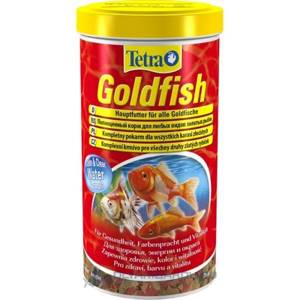
- JBL. German company producing high-quality fish food using modern equipment. The products of this company are considered one of the highest quality in the world, leaving competitors behind.

- OTTO. Produces enriched with microelements, acids and vitamins dry food that allows crucian carp to quickly reach a high weight in a home pond.

What to feed
The diet of fish can consist of industrial semi-finished products. In any specialized store you can purchase various types of fish food.
Along with ready-made food, pets' rations should consist of earthworms, bloodworms, scraped meat, and larvae of various insects.
The owner should not worry too much about what to feed the crucian carp in the aquarium. The fish are quite unpretentious in food. They eat both animal products and pieces of vegetables and fruits with equal pleasure. The main thing is that the fish do not overeat, otherwise they risk obesity. The optimal feeding regime for crucian carp is twice a day in standard portions.
Type of fish and food used for breeding fry in a decorative pond at the dacha
Several types of crucian carp are grown in artificial reservoirs:
- crucian carp or golden carp;
- goldfish;
- gold fish.
The first two species are found in natural bodies of water; goldfish were artificially bred in China and are a popular decoration for home ponds. Breeding any species involves feeding them.
Read more about fish farming in artificial reservoirs here.
Rules for feeding in a country pond at home
With insufficient nutrition, crucian carp degenerates and becomes smaller, and is capable of forming a dwarf form. The question always arises of what to feed crucian carp in a home pond.
In nature, the basis of the diet of crucian carp is:
- chironomid larvae (bloodworms) and other insects;
- small shellfish;
- worms;
- seaweed.
This type of fish needs to be fed starting from the end of April–May. In mid-September, feeding is stopped. Crucian carp eat food well only in well-warmed water. In hot and cold weather they stop feeding. Water temperatures above 25 and below 12 °C are considered critical. Experienced fish farmers will not carry out feeding without a thermometer in hand, otherwise it will cause harm instead of benefit. Compound feed will settle to the bottom, decompose and negatively affect water quality. This process can cause eutrophication of water bodies.
The process of feeding fry and adult fish
A home pond of almost any size and design is suitable for raising crucian carp. In principle, crucian carp are omnivores. Even if you don't feed them, they won't die of hunger. In a home pond, they will always find the minimum food necessary for survival, especially if the pond has a muddy bottom, there are many plants and its own ecosystem has already developed.
How often and in what quantities to feed
The question: how to feed fish is relevant only in the warm season: in winter, fish do not eat, and there is no point in feeding them. In properly created conditions of a home pond, golden crucian carp grow up to 500–600 grams. In two years, silver crucian carp gains weight up to 250–300 grams. In order to get such results, the fish need to be fed correctly.
Feeding rules:
- feed is given 1–2 times a day;
- feeding is carried out in the afternoon;
- They give exactly as much food as the crucian carp can eat in 15 minutes.
If the fish in your pond are breeding, then everything is fine and the food is suitable for them. The amount of feed is calculated based on the number of fish and the type of feed. Cereals are given at the rate of: 3-5% of the total weight of fish in the pond.
How to make a trellis for climbing plants with your own hands is described in this material.
If your pond has 30 crucian carp of 100 grams each, then for one feeding you will need 90–150 g of steamed grain. It is mixed with meat waste, bran and bone meal. By autumn, portions are reduced, and with the onset of cold weather they stop feeding altogether.
We also recommend that you read the material about skimmers for ponds.
Breeding crucian carp as a business
- Breeding cyprinids is very profitable, since this fish is unpretentious and omnivorous. Among other advantages:
- lack of cannibalistic habits;
- they do not fight each other for food;
- disease resistant;
- can gain weight quickly;
- eat inexpensive food;
- can move and get food in different layers of water.
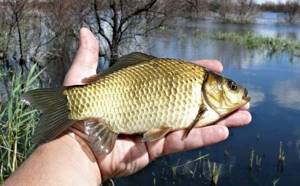
Most people breed fish “for themselves” as an additional source of pleasure and income. But if you decide to take it seriously, the growing population of cities will provide any farmer with reliable markets for their finished products. Additionally, you can continue to use the pond for other purposes. For example, growing crayfish.
What is needed for this
Fish that live in freshwater reservoirs will successfully grow in a plastic pool, which is placed in a polycarbonate greenhouse. This also allows you to organize a spawning pool if necessary. This method is the simplest solution if it is not possible to build a pond. It is also necessary to purchase compressor and filtering equipment, which will cost a certain amount. It depends on how powerful the units are needed.
Pay attention to the information about constructing a butyl rubber pond.
Analyze the equipment needed for fish farming:
- A biofilter is a device for water purification. Its installation will take a couple of minutes. Filtration is necessary so that the fish do not die from the high content of toxins that arise during the breakdown of food residues, algae and pond animals.
- To organize the movement of water you will need a compressor.
- To eliminate blooms, you need an ultraviolet sterilizer. It purifies the water supplied by the hydraulic pump.
- You may also need a fish feeder so that you can reduce the waste of food and the breakdown of its residues in the pond.
Advantages and disadvantages
- When considering the issue of growing crucian carp in a home pond, the following advantages can be noted:
- rational use of the pond on the site;
- regular inclusion of fish dishes in the diet;
- generating income if the pond and livestock are large enough.
There are no disadvantages to growing fish, but there are some peculiarities. So, in the absence of basic knowledge, a fish farmer will make mistakes, and this can negatively affect his fish, and then his enthusiasm, so start by raising a small batch of fish and, only after practice, move on to creating a farm.
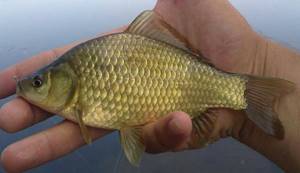
If you follow all the rules and approach the issue with all responsibility, then breeding crucian carp will bring joy, and can also diversify the menu and may even add some money to your income. Read in advance all the information on how to properly build a pond, get fish and feed them, and keep them healthy and productive. Also take care of devices and additives that ensure the correct composition and properties of water, feeding and wintering. And remember that you cannot overpopulate a reservoir - this will contribute to the development of diseases.
Breeding in captivity
Crucians reproduce well at home. The readiness of males to fertilize a female is indicated by a specific spawning rash on the gill wings.
To breed crucian carp, you need a pair of individuals or a group of fish with a predominance of males. Selected pets are placed in a special spawning aquarium, where the bottom surface is lined with driftwood to secure the eggs. There should also be plants or algae floating on the water. In favorable conditions, the fry can hatch already on the third day after spawning. It is best to remove newborn fish from their voracious parents. What to feed crucian carp in an aquarium immediately after birth? It is best to use brine shrimp or special artificial feed for young animals.
Breeding Features
There are two types of crucian carp:
- gold (ordinary);
- silver.
Common crucian carp is the most common species, but for direct breeding it is much preferable to use silver carp:
- smaller in size, which means it can live in smaller bodies of water;
- the growth rate is noticeably higher;
- gains weight much faster than goldfish.
The crucian carp itself is a type of fish with a very strong immune system. Diseases such as rubella or branchiomycosis rarely affect crucian carp, unlike the same carp and any other species of fish. High resistance to such serious diseases is an essential factor when choosing fish for breeding.
Another serious advantage of crucian carp is their unpretentiousness: combined with a strong immune system, crucian carp becomes an extremely convenient species for breeding. For the same reasons, this fish can be kept in harsher conditions than any other.
Also, crucian carp perfectly adapt to winter conditions. When a reservoir is covered with ice, they are ready to eat literally any food they can find. And such actions will not affect their health and lifestyle in any way.
Ready-made feed
Today, every beginner or experienced fisherman can stock up on ready-made food for their favorite “ward” fish for future use; it should include ingredients like:
- vitamins of group B, A, E, D;
- fat;
- gland;
- manganese;
- fiber;
- yeast;
- cobalt;
- protein.
There are also special premixes for fish on sale that allow for rapid weight gain of crucian carp, while the best purchased food is the one that contains from 20 to 35 percent protein, 10 percent fat, 7-10 percent fiber, and the food must meet the highest quality standards.
Pet's neighbors
If several species of fish live in one vessel, it should be taken into account that representatives of the carp family soon become leaders in the local community. Existing in an aquarium with other fish, crucian carp can simply eat their neighbors. As a result, it is recommended to place close relatives of pets or fish that can stand up for themselves and their offspring in one container.
The optimal species for companionship with crucian carp are goldfish, telescopes, veiltails, and celestial eyes.
When keeping several species in one aquarium at the same time, it should be taken into account that crucian carp love cold water. Therefore, there can be no talk of any discus, guppies and neons.
Other interesting articles
- What fish can live without aeration, air in the aquarium? What fish can survive without oxygen and filtration? No living creature can live without...
- How long do catfish live in an aquarium at home? The aquarium catfish is not just an unusual fish whose behavior is very interesting to observe, but also...
- How long do turtles live at home in an aquarium? When getting any pet - a parrot, fish, rabbit, cat or turtle, there is a natural desire to find out...
Meet the crucian carp
Crucians belong to the carp breed. There are five species of this fish, of which two are the most famous:
- golden or common crucian carp (grows up to 50 cm in length, weighing up to 3 kg or more);
- silver crucian carp (grows up to 40 cm and weighs up to 2 kg).
Crucian carp lives in almost all reservoirs of Central and Eastern Europe, in addition to Siberia and the Far East. It prefers standing water to running water, and does not take root at all in mountainous areas. Crucian carp lives not only in lakes and ponds, but even in semi-underground reservoirs.
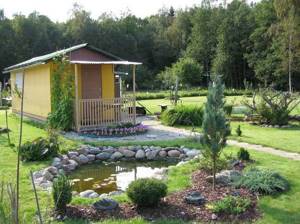
Choosing a location for a pond is very important. Most of the day it should be in the shade, there should be no trees nearby, and it is better to make the exit to the water inclined.
In winter, this fish hibernates, and is able to survive even in severe frosts, when the water freezes to the very bottom. Crucian carp feed on vegetation, small animals, crushed bottom remains, in general, everything that the river god sends them.
Cooks highly value crucian carp meat, which, according to them, is not inferior to carp meat.
For all its advantages, crucian carp grows very slowly. During the first year of life, under normal conditions, the fish is able to gain 20-50 g of weight. Two-year-olds reach a weight of 150 to 300 g, but this depends on the climatic zone of their habitat. However, if you feed the crucian carp correctly, this process can be accelerated, and by the age of two years it will already weigh up to 400 g.
It is recommended to build a special platform for feeding fish. To prevent leftover feed from clogging the water and rotting, use special feeding trays. You can make them yourself or purchase them. Having lowered such a tray-feeder to a depth of 0.5 m, feed is poured into it. After the fish has eaten, the feeder along with the remaining food is taken out of the water.
Manufacturers
There are several types of dry food: for fry, for commercial fish and for feeding fish in the pond.
Mixtures should be used carefully for other animals, in small portions. If you don’t want to take risks, pay attention to ready-made, high-quality food that has proven itself well. Some types also have a healing effect.
Find out what pond aerators are in this article.
Tetra
The company is a leader in the production of products for aquariums and garden fish farming. For cold-water fish, she offers the following food:
- Tetra Pond Sticks (universal food in the form of floating sticks);
- Tetra Pond Sticks Mini (food for small fish, suitable for fry);
- Tetra Pond Color Sticks (food that improves fish color)
- Tetra Goldfish (flakes and sticks for goldfish and other crucian carp);
- TetraPond Holiday (for feeding pond fish during vacation);
Nutritious food is suitable for all types of cold-water fish, including crucian carp. Price for 250 ml jars – from 150 rubles.
JBL
Goldfish food from this company is well suited for providing proper nutrition for crucian carp in a garden pond. The following foods are suitable for crucian carp:
- JBL NovoRed (universal food in the form of flakes);
- JBL NovoPearl (universal food based on wheat germ);
- JBL NovoRed refill (universal food in special packaging).
The price of a 100 ml jar is from 110 rubles.
Methods for growing crucian carp
Crucian carp are freshwater lake and river fish that live in different countries of Asia and Europe, including Russia. They typically live in the lower layer of the water column, so they can tolerate a wide range of environmental conditions. These fish can reproduce in the same body of water in which they were born, without migrating anywhere to do this.
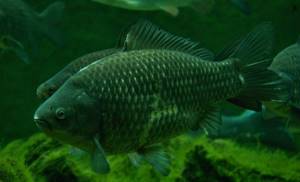
As for the methods of breeding fish, there are several of them:
- Traditional. Breeding takes place on the basis of natural food. It is believed that this method is ineffective due to poor weight gain.
- Semi-intensive. All work is carried out on the basis of scientific rules and recommendations.
- Intensive. The fish are raised using methods that produce maximum weight in the minimum amount of space.
Important! If the depth of the reservoir exceeds 80 cm, then the banks must be made with protrusions, otherwise they will slide and deform the pond.
Breeding
To properly start your mini fish farm, consider the breeding steps. This will help you better visualize the end result over any time period.
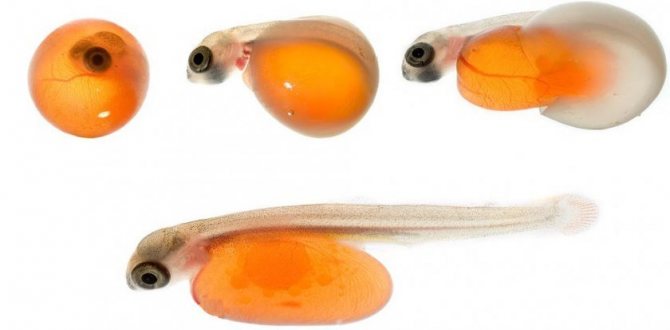
Main stages:
- First, fish spawn.
- Then it develops into fry
- After which he gains weight of about 200 g.
- Then the fish spends the winter.
- The next year of development begins in spring. Many fish farmers consider this stage to be the final stage. The fish are caught and sold to stores or used at home.
Here you can learn about creating a pond with the ability to swim in it.
Currently, artificial propagation is the main source of obtaining crucian carp from reservoirs. You will need:
- silver carp (carassius gibelio);
- golden carp (Carassius carassius).
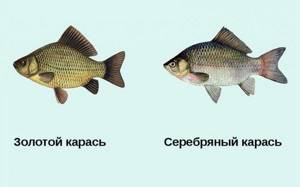
They can interbreed to form hybrid offspring. Ichthyologists note that a female silver crucian carp and a male goldfish produce female offspring whose growth rate is 30–40% higher than that of their parents.
A separate area is prepared in a pool or pond for spawning. After a while, the grown young animals are planted in the main reservoir. You can also use a plastic pool for spawning.
Did you know? Crucian carp is even involved in traditional medicine recipes. An alcohol tincture is made from its teeth to treat kidney and bladder stones.
Hatchery production:
- Selected mature fish are released into spawning tanks. They do not need to be injected with hormones, since crucian carp reproduce well without them. But if done, it will allow it to reproduce synchronously and the fry to hatch almost simultaneously.
- The female will attach the eggs to aquatic plants. For better removal, you can place it in a pond with running water. Substrates with eggs attached can simply be hung in the water column in a jar to protect them from other fish. And after hatching and some growth, the fry will be released into the water.
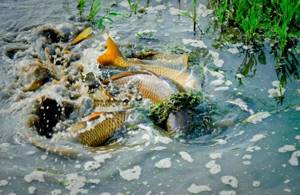
Raising fingerlings
The planting density of caviar is usually 1.5–2.25 million pieces/ha. The exact volume depends on the length of the growing period. The later the fish are removed, the less caviar there should be.
Young crucian carp reach a size of about 30 mm 2–3 weeks after hatching. They are called summer fry. When they are transferred from the nursery pond to a regular pond, they will need to be kept in a pen to reduce the effects of the stress of the transfer.
